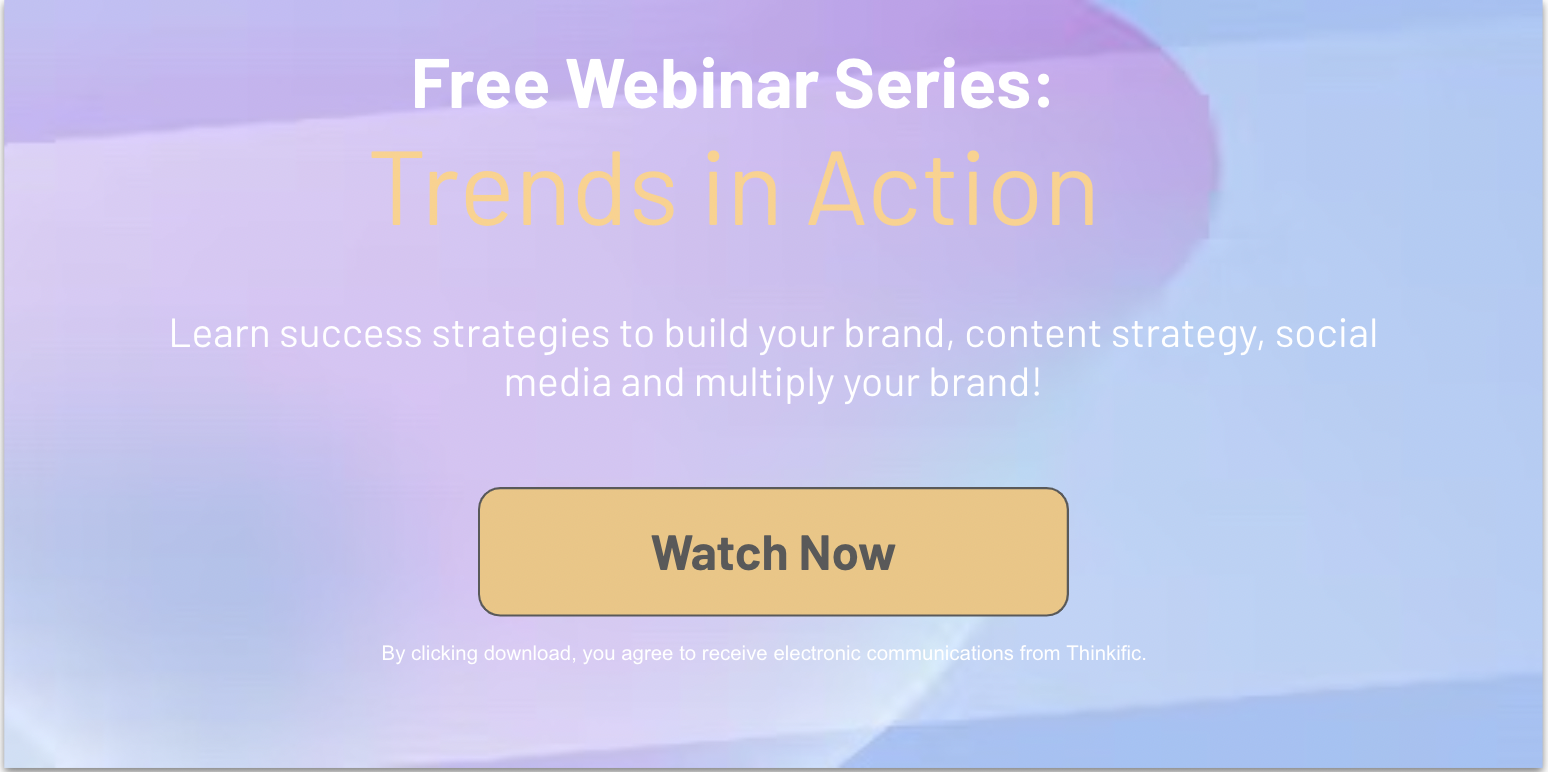Whether you’re an online course creator, eCommerce store owner, B2B business, or a Fortune 500 company, learning how to build an online community is invaluable.
Of the many benefits, online communities can drive traffic to your website, strengthen your relationship with customers, and increase your business’ revenue.
In this article, you’ll learn exactly how to create an online community in 7 actionable steps—supported with real-world examples from successful community leaders, entrepreneurs, and online course creators who’ve built their own highly engaged communities. Let’s get started!
Skip ahead here:
- What is an online community
- Why build an online community
- Common types of online communities
- Learning Communities
- Brand Communities
- 7 steps to building an online community
- Conclusion
Our community is a crucial part of our membership. It’s a well known saying that members will come for the content, but they’ll stay for the community. Our whole team has a presence there as they understand just how important it is to actually show up and interact with our members.Mike Morrison, The Membership Guys
What is an online community?
Simply put, an online community is a shared space where members engage with each other. Typically, online communities are built around the common interests, opinions, or goals of the members.
The kind of community you build depends on your business goals. A community for a fitness coach may look like a private Facebook group for members of their fitness program to share knowledge and transformation stories. For a photographer, it may be an open forum for thousands of members to gather, share resources, and give feedback on others’ photography.
Whatever your platform of choice, online communities are a powerful way to facilitate meaningful connections between your followers because they allow your audience to:
- discuss topics that interest them
- engage with a brand, online course instructor, or another leader
- learn together
- collaborate on personal projects or course goals
- share advice and related news
Why build an online community?
As a business owner, online communities bring your audience or students together in a single place where you can ask questions, observe their progress, and receive helpful feedback.
For brands like Thinkific, an online community is a way to bring our current and potential customers together in one place to share ideas, discuss strategies, and get actionable feedback on our product.
➡️ Build explosive growth & revenue with community + 3 bonus cheat sheets
Want more business tips to unblock you? Sign up for the newsletter here.
Benefits of online communities
Regardless of your team size, there are many common benefits to creating an online community:
- Be seen as a leader in your space. Expand your sphere of influence by growing your network and audience.
- Create brand ambassadors. Increase referrals to your business by way of brand evangelists.
- Feedback from your audience. Having a regular dialogue with your community lets you improve your products and services and helps you serve them better.
- Increase revenue. A community will help foster more engaged followers and increase retention, which can ultimately increase sales.
- Respond to market shifts. Digital communities help you maintain touchpoints with your audience when being in the same physical space isn’t possible.
- Online communities are a natural fit for digital entrepreneurs. Two of Thinkific’s most successful course creators didn’t actually start out with courses on day one. They started out creating niche professional learning communities on Facebook.
Kate Baker created a group called The Veterinary Cytology Coffeehouse for veterinary professionals who want to learn more about veterinary cytology and hematology. In its first year, the group grew to 35,000 members without any advertising. Today it boasts over 67,000 members. But she didn’t start her group hoping to monetize it—it was only after her group members began to ask for courses and more information that she made the leap.
Similarly, Latrina Walden created her course after starting a successful study group for nurses. After hosting several live Q & As, she received an overwhelmingly positive response, with group members calling for more materials, which led her to begin selling online courses.
Both of these entrepreneurs ended up building online learning communities that eventually gave them the push and the validation they needed to create online courses.
Feeling like an online community could be in your future? Along with the many different platforms that can host communities, there are also different kinds of communities, each of which can affect how your community functions. Let’s take a closer look at each.
Related: It’s Time to Tap Into Togetherness with Communities
Common types of online communities
Of the many different types of online communities, we’ve isolated the six we think you’ll encounter the most. They are:
- Interest. A group brought together by a common interest or passion, like Thinkific’s Facebook group for Online Course Creation.
- Action. Communities that come together to bring about change. For example, Black Lives Matter activists forming a group to plan rallies.
- Place. Communities within geographic boundaries. For example, a Facebook group focused on things to do when visiting Vancouver, Canada.
- Practice or Profession. Also referred to as a community of practice, this is when members of a particular profession come together to share professional development tips and learn how to excel at their jobs. For example, teachers forming a group to further their professional knowledge.
- Learning. These are communities that focus on shared learning goals. Those goals may relate to a profession but may also relate to a hobby or nonprofessional goal, like learning how to roller skate.
- Brand. Communities centered around a common mission, goal, or lifestyle championed by a business or brand.
Of these six different types of communities, learning communities and brand communities are the most useful for course creators.
What is a learning community?
A learning community is a group of people with similar learning goals who meet to discuss course topics and assignments. Online learning communities complement online courses because they enable social learning, peer-to-peer support, and student-to-instructor support. They also help with accountability, as students can be paired or placed in cohorts to hold each other accountable for learning goals.
Research from the 2023 Digital Learning Trends Report highlights the value of learning communities:
- Nearly 60% of Gen Zs say that online community is very important to them.
- Nearly 50% of online community members are actively engaged, more than 10 times the engagement rates seen on traditional social media.
- Full-time creators are more likely to make money from recurring revenue systems like communities than part-timers.
Tiffany Aliche’s online community is an excellent example of a learning community in action. She’s built a wildly successful online membership community teaching women about personal finance. Members of her community are often participants in her online program and log on to discuss learnings and progress toward financial independence.
Other examples of learning communities include:
- Kate Baker, an online community creator turned course creator after starting a Facebook group for veterinarians.
- The Zealous Art community, founded by Freda Lombard to promote and support her Zealous Art courses.
- Latrina Walden, a former nurse who created a community to help nurses with exam prep before expanding into online courses.
- Dana Malstaff, who created Boss Mom, offers resources, community, and guidance to entrepreneurial moms.
Why build a learning community?
Many of our top course creators can attest that learning communities improve student outcomes, including retention, test scores, and completion rates. They also improve course creator outcomes because happy and engaged students will stick around longer, refer their friends, and buy more courses.
Monetizing your expertise through learning communities
The growing trend of monetizing expertise through learning communities is evident in the following stats:
- Nearly 60% of surveyed Thinkific creators are currently selling or planning to sell an online community as a learning product.
- 53% of people say they’re more likely to buy a product if it’s recommended to them by a member of a community they belong to.
These numbers suggest that there is a significant opportunity for course creators to benefit from the trust, connection, and credibility built within a strong community of like-minded members and learners.
Benefits of learning communities
Key benefits of learning communities include:
- Social learning: Communities allow students to learn from teaching others and asking questions.
- Faster answers: Questions get answered faster in communities without relying on a response from the instructor.
- Course production ideas: Our top course creators continuously listen to what questions people are asking or what challenges they have. They use this information to anticipate the needs of their students and develop more course material or other offerings.
- Cohort-based Learning: Cohort learning gives learners the sense of community they crave while improving learning outcomes. Members benefit from a supportive network and more accountability.
Related: Learn how Thinkific Communities can unlock new possibilities for your business
What is a brand community?
A brand community is a group of customers, partners, and employees—brought together in one place to support each other, provide input, and ultimately develop deeper emotional connections to a brand.
This type of community can be hosted by a company on its website or in a group on Facebook, but it’s not limited to one or the other.
Our brand community was built to bring Thinkific, our customers, and experts together in one place—centered around our platform and the success of our users. (In the next section, we’ll share some specific examples of how our community creates value for all stakeholders involved.)
Another example of a brand community is Brit + Co’s creative community. It’s built on Thinkific and designed to complement their online course and membership site. In their community, students can share inspiration, ideas, accomplishments, and their journeys in the creative space.
Why build a brand community?
Whether supporting your customers or testing product ideas, the concept of online communities has moved far beyond being a social media strategy.
Brand communities don’t just change the company’s marketing strategy. Companies report an overall deeper insight into customer needs and product designs. Brand communities benefit companies because members buy more, remain loyal, and reduce marketing costs through grassroots evangelism.
Benefits of Brand Communities
Some of the many benefits brands are seeing from their communities include:
- Direct communication with customers – brands have another way to communicate with customers for sales and customer service inquiries
- Product feedback – brand communities create a forum to test ideas and get feedback from your core customer base before making product decisions
- Customer acquisition – communities can attract new customers and help build trust, helping with conversion
- Customers supporting customers – customers can help each other with questions, and as a result, the burden of support doesn’t rest solely on your shoulders
- Loyalty – having a strong product or service will only get you so far, brand loyalty often comes from a strong active community
- Customer retention – better support and a better customer experience will lead to better retention
To illustrate the value a brand community can create, we’ll share a few key benefits and examples from our own brand community.
Motivation and reinforcement
Imagine how impactful it would be if your users could support other users, motivate each other, and share success stories.
In our brand community, we celebrate wins and share best practices to ensure when one member of the group wins, we all win.

Product feedback and feature requests
It’s easy for brands to miss the mark on their communities by limiting their stakeholders (moderators and admin) to internal Marketing or Support teams.
Thinkific’s brand community has been a significant source of product ideas and feedback. A few of our integrations, like our connection with Constant contact, can be attributed to insights from our group.
When we see pain points and feature requests, we’re able to hear their side of the story and see how their idea is received by the community. If dozens of people comment in favor, that’s a pretty telling sign. And since all the content is archived, we can get even more context by using the group search feature to see how many times that feature has been requested.


Announcements and Soft Launches
An online community is an incredibly effective way to make product announcements because it allows you to generate discussion and engagement in more meaningful ways than email can. In Peter’s case, he needed to tap into our community of engaged course creators to test out a new feature.
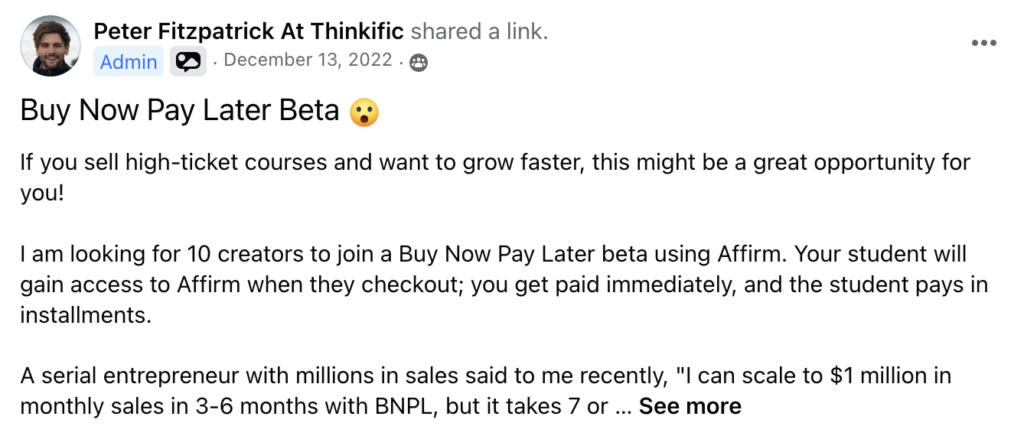
Content ideas
Another benefit of our community is our ability to scan the discussion, find knowledge gaps, and to fill them. If many people are asking the same questions, we need to do a better job of educating them through our content.

It’s questions like Monica’s that encourage us to create posts like these: how to build a landing page and landing page examples.
7 steps to building an online community
Now that we understand the difference between learning communities and brand communities and their benefits, let’s walk through the 7 essential steps to building a successful online community:
While a community can have multiple goals, it’s best to focus on a small number of goals that represent value created for you and your community, and can be tied to specific behaviors and outcomes.
You’ll also want some tangible metrics, called Key Performance Indicators (KPIs) to measure how successful you are at reaching your goals.
Understanding the value of community
To understand how to build a community, it’s important to understand what actually creates a sense of community and how members get value.
Long before online communities existed, community psychologists described four timeless factors that define a sense of community. They are:
- Membership: A sense of belonging and identification, alignment with other community members with similar goals and interests.
- Influence: Members of a community should feel empowered to have influence over what a group does (otherwise, there’s no motivation to participate), and group cohesiveness depends on the group having some influence over its members.
- Integration and fulfillment of needs: Beyond the status of being a member, members should feel rewarded for their participation and get value from being part of the group.
- Shared emotional connection: Quoted as the definitive element for true community, a shared emotional connection comes from quality interactions and bonds that are created. Your emotional connection to a community can be elevated by receiving credit from within the community and is diminished if you’re embarrassed in front of the community.
This is helpful to understand because these are the boxes you need to tick to create a valuable community for your members.
Aligning value with behavior
A community-based brand builds loyalty not by driving sales transactions but by helping people meet their needs.
Next, you’ll need to find ways to turn that community value into specific behaviors that create this value.
Here’s an example of key values and corresponding behaviors for learning communities and brand communities:
| Value | How value is created | Behavior that creates value |
| Learning Community | (1) Connection & discussion with peers and instructors that supports learning | (1) Asking questions, and getting answers from students and the instructor |
| (2) Students analyze scenarios and apply knowledge | (2) Debating on solutions to questions posed by instructors and peers | |
| Brand Community | (1) Enhanced customer support and customer retention | (1) Customers can share questions and success stories, with feedback from other customers and the brand. |
| (2) Product Innovation | (2) Product stakeholders engage with a beta testing community to get valuable feedback that guides product design | |
| (3) Brand Loyalty | (3) Brand community members accumulate points for creating community value that unlocks bonuses & discounts. |
Community KPIs
Key performance indicators are used to measure your progress against a goal. They should be SMART: Specific, Measurable, Realistic, and Time-bound.
While your KPIs will vary depending on your community’s purpose and the platform you’re using, a few KPIs are universal.
Community KPIs to consider
| User Growth |
|
| User Engagement |
|
You’ll want to keep track of these KPIs and review them regularly. The best insights will come from comparing these metrics against the previous time period, for example:
- year over year user growth
- new users in the last month vs. the previous month
While user engagement and growth are great, you’ll need some KPIs that are aligned with your business goals.
If you’re an online course creator, you’re more interested in how many courses people buy or what happens to your student completion rates or quiz scores.
If you’re a membership site owner, your community is a big part of the product you’re selling and will help you gain and retain members.
A brand, like a software company, may have completely different objectives for its communities, like customer retention, new sales, and actionable product feedback.
Here are some KPI ideas for both:
Learning community KPIs | Brand community KPIs |
|
|
It’s important to have rules and a moderation strategy to keep your community free from trolls, spam, and abuse.
Community rules and guidelines make clear what kind of behavior is appropriate for the community.
Facebook highlighted a few key tips for writing great group rules, but to sum it up, community guidelines will typically cover the following areas:
- Member behavior (and what constitutes “being a jerk”) – what is expected of members, and what line is drawn between passionate debate and simply being a jerk
- Moderator behavior – what moderators can and can’t do
- Topical focus – what topics are in scope for the community? What topics are irrelevant?
- Complaint and resolution process – how can people flag complaints, and how do you handle them?
- Zero tolerance for discrimination and harassment – it’s a no-brainer that everyone should feel welcome and not alienated by your community
Here are the group rules we use for our brand community for course creators:

Related: How to Create Community Guidelines (Examples + Template)
When most people think of online communities, they think of social networks like Facebook or LinkedIn, which allow users to create groups and pages to engage their following.
Having a social media community doesn’t necessarily mean you have a community strategy. To highlight the difference, we’ll compare and contrast, then we’ll share how to use both.
Related: The Top 10 Online Community Platforms Compared
Free social community platform
Facebook, LinkedIn, and Reddit are great examples of free platforms that you can build a community on.
There are two major benefits to using social media platforms to house your communities. They are:
- They’re free. Building a community on social media only takes time and effort.
- Native users are looking for you. A large portion of your audience are native users, which means they’re familiar with the platform and how it works. That also means you’re more likely to get discovered organically as people search for communities like yours on the platforms they’re already using.
On the other hand, there are a few drawbacks to using free community platforms:
- No real ownership and control. While you’re free to make the rules within your group, add and remove members, and delete content, you don’t actually have ownership over the platform.
- Distractions. Since social networks are designed to generate advertising revenue, it’s difficult to create an experience that is free from distractions.
- No way to fill your funnel. Group members do not have to give you their email, or payment to join.
Branded community platforms

Branded Community platforms (aka Owned Communities) are run by community owners from their own platform, under their own URL.
A branded community could be as simple as a comment section on your blog or a private forum. But with Thinkific and other platforms, you can build your own community where users can log in, post content, and engage with other community members.
The major advantage of branded communities is that you’re in full control of the content, the branding, and the experience.
Since you control the content on your own platform, your users can enjoy your community free from distractions like ads and other content.
The other major advantage of owning your community is that you can charge people for access, like subscription membership sites, for example.
One of the drawbacks is the learning curve for members to learn how to create their profiles, log in, and start posting on a new platform. Discoverability is another consideration – if you’re hosting your community exclusively within your own platform, you’ll need to find other ways to promote your community.
Here is a screenshot of how a branded community built on Thinkific works:
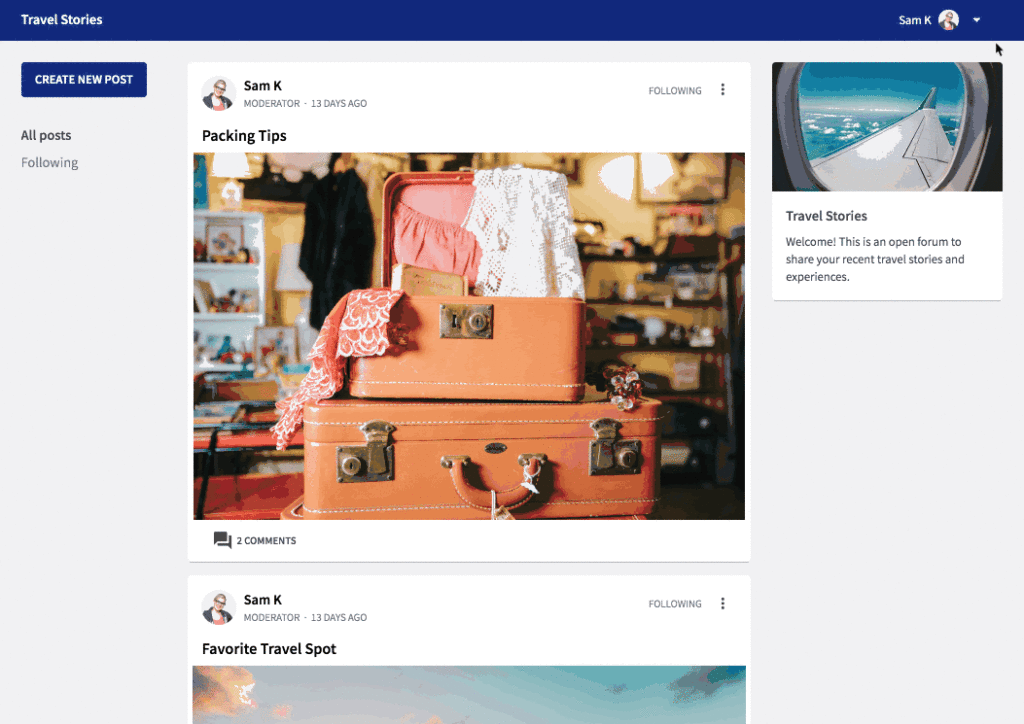
A case for using both free social communities and branded communities
You can think of social networks as an extension of your overall community strategy, but they’re not the be-all-end-all because community elements can be hosted on your website.
There are benefits to running your community strategy through a combination of free and owned communities.
Here’s an example of how a brand might approach their community strategy, including both platforms:
| Example Tactic | Platform Value | Stakeholders | |
| Free Social Media Communities | Webinars and Promotions | Visibility, discoverability, reach, easy onboarding. | Sales & Marketing |
| Branded Community Platform | Product Feedback | Control, exclusivity, tighter audience, gated | Product & Support |
Sales and Marketing may want an outlet to engage with their prospects and customers.
A Facebook group would be a great place to post new deals, or webinars, and your community would be discoverable to new potential members. Success stories, like Tien’s, posted within the group can help reassure or motivate your customers, or even inspire new prospects to convert.

But let’s say you wanted to give your best customers a sneak peek at a new product you’re working on without tipping off your competitors or sharing with the masses. Or maybe you want full control over building and customizing your community or even charging for it! That’s when a branded community could come in handy.
If you’re a solopreneur, congratulations – you are the only stakeholder to consider. As a solopreneur or even part of a small team, you likely have to wear many hats when it comes to managing your community.
Once your community grows to the point where you’re spending more time working in the community than on your business, a community manager would make a great addition to your team. If you don’t have the budget to hire someone, consider reaching out to active members of your community to explore whether they’d be open to helping you moderate the group. In many cases, moderating a large group is a professional accomplishment.
Larger brands like Google and Facebook and mid-market brands like Thinkific and Brit + Co will have multiple stakeholders across the organization who should be involved, which means their community may spill over into multiple platforms.
The following table maps out a list of common stakeholders, their strategic value, and the types of tactics they might implement with your community.
| Stakeholder | Strategic Value | Tactics |
| Marketing | Newsletter subscribers | Ask for emails in the membership questions that members answer before joining your group |
| Sales | Sales promotions | Announcing sales promotions within the group |
| Support | Leveraging your community to answer support questions | Create a support community forum where customers can ask/answer questions |
| Product | Product feedback. User pain points, motivations, Product Suggestions | Share new product updates and ask for feedback |
Our whole team has a presence there as they understand just how important it is to actually show up and interact with our members.MIKE MORRISON, THE MEMBERSHIP GUYS
Now that we’ve covered the options for where to build your community, we’ll cover the steps involved in setting up your community.
Thinkific Expert Kim Garnett offered some tips for implementing learning communities with Thinkific:
Firstly, make sure you invite your students/learners! Add a lesson to your welcome chapter, and the welcome email, with a link to join the group and a summary of what they can expect by joining. It will certainly take more work on your part at the start of building your online community. Posting prompts and encouraging interaction will land on you, at least until the community begins to grow and co-create more group content.
KIM GARNETT
Another Thinkific Expert, and recent co-host of our annual Think in Color series, XayLi Barclay created an excellent step-by-step guide to creating a community on Thinkific:
Your options may differ depending on what platform you’re on, but this is the general flow of steps you’ll need to take when setting up your community:
Customize your community
If you’re hosting your community on your own platform, you can customize things like fonts, colors, and key imagery, without the noise and distractions that come with social community platforms.
Whether you’re building your community on social media or your own platform, make sure to update your group description, profile photo, and cover photos.
- Community Description
The community description is like your elevator pitch – it should capture the essence of your community in one quick read.
Brit + Co’s description communicates who the community is for and what people can do in the community, along with a friendly reminder that they are a positive, encouraging, and accepting community:
- Cover Photo
Your cover photo is the most visible thing when users first click into your community, making it the perfect piece of digital real estate to brand your community and your business.
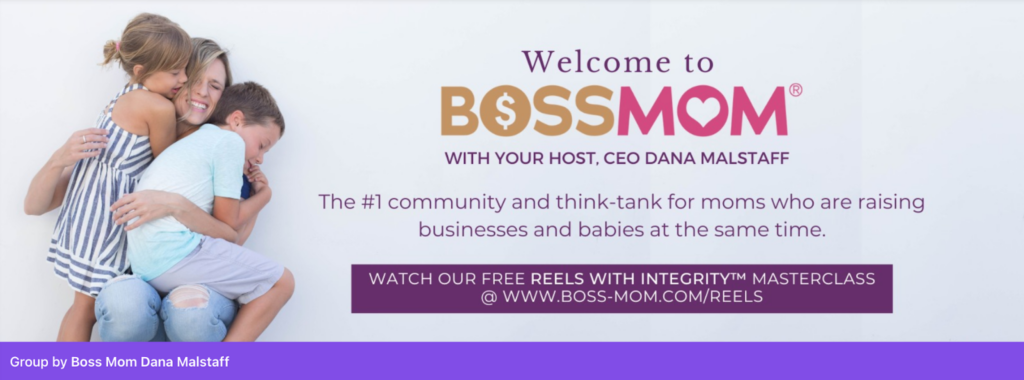
Dana Malstaff, an online course creator and successful community builder, is the founder of Boss-Mom® – a community for entrepreneurial moms. She created a group cover photo that accomplishes a few things:
- It creates personal branding
- It tells you what the community is about with a tagline
- It has a call-to-action for free training
- Membership questions
You may also want to add membership questions that people answer when they’re requesting to join the group.
Thinkific’s community asks how people found us, if they have an account with us, and for permission to add them to our mailing list. Sharing an email address is an easy way for members to give you value in exchange for the value they’ll receive from the community.
Still, if you want to soften the ask even more, you can offer freebies for new members, which is a common email list-building strategy.

- Linking your group to your business page
If you’re using Facebook Groups, It’s a good idea to link your group to your business page. This will help community members follow your non-community posts and help drive a little more traffic to your site.
Define the roles and responsibilities of your team
If you’re a solopreneur, you’re on the hook for just about everything. But once your community reaches thousands of members, you’ll likely need help.
Your strategy will dictate who you’ll need, but generally, here’s what your team could look like:
- Daily administration: Many companies hire community managers to handle this task. But it’s also common for customer support or a social media manager to manage the community when it’s starting out.
- Webinars: If you’re going to host webinars for your community, you’ll need someone to appear on-screen, moderate the chat, let people into the meeting, and help with audio and video.
- Support: Who will be responsible for responding to “how to” requests and other support issues? This is especially important if you offer a product or service.
- Sales: Who will be responsible for responding to questions about pricing and packages?
- Product: Who will be tapping the community for product ideas and responding to feature requests?
Group topics
Hashtags and pinned topics make it easier for your members to find what they’re looking for. Administrators can tag posts and create group hashtags that are then featured right next to the main feed for quick access. Here are our top three topics:
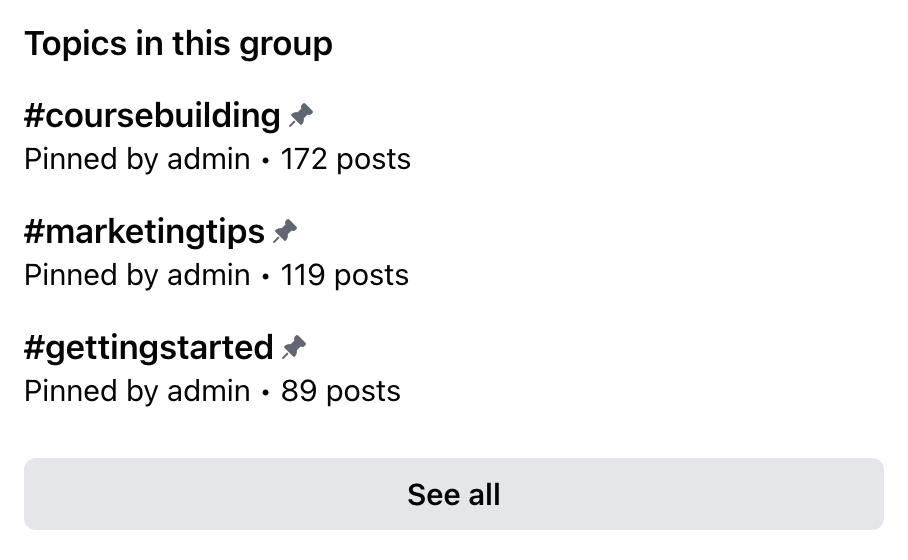
Review and test member account creation and sign-in process
To ensure a smooth launch, you’ll want to jump into your customer’s shoes and give the account creation and sign-in process a trial run.
This will help you view the community from their perspective and make sure they’re approved and given access to everything they need.
If you have a small team or some close friends, try asking them to run through the creation and sign-in process too. Testing the process more can only bring you more confidence that it’s working correctly.
Set up welcome messages and onboarding content
Staying in your customers’ shoes, ask yourself the following questions:
- What is the first thing they see when they join the community?
- Do they know how to use the community? What to post? Where to post?
A welcome message pinned to the top of your group will help set your new community members up for success.
Another great way to welcome new community members is to tag all your new members for the week in a post. Encourage them to introduce themselves and invite the community to welcome them.
The key to learning how to build community online, is learning how to build engagement. The more engaged your community is, the better your results will be.
Start by setting the tone for your community early and sparking opportunities for members to engage often.
Check this article out for a more exhaustive list of online community engagement ideas. Here are a couple of key tactics to get you started.
Create a theme for each day of the week
Creating a theme for each day of the week is a fun way to keep your community focused on the topics they came for. It’s also a great way to give your members ideas for what to post.
Here’s an example from the Becoming a Blogger Facebook group:

On top of stimulating conversation in the community, these posts also help give users a place to network, brag, or even self-promote, something explicitly banned outside of that one day of the week. Here’s a look at what the Sunday post looks like:

Ask questions and spark group discussion
This is a great way to spark discussions and create engagement within your group.
There are many benefits to incorporating topics for group discussion into your online community. For one, it can help to promote critical thinking and analysis.
It can also be a great way to get different perspectives on controversial or hot topics, which may help group members process changes in their field or industry. An excellent example of this is a question we recently posed to our Thinkific community:
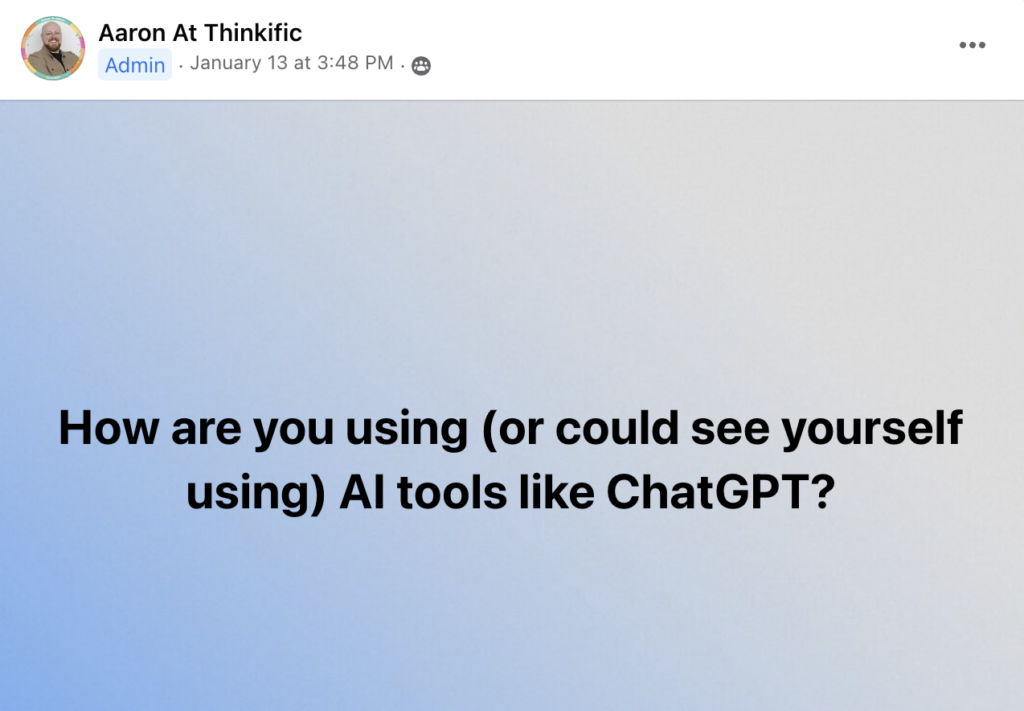
ChatGPT is a hot topic and it really gets people excited to…should we say, chat about it. In this scenario, Aaron used the question to get people to share about these hot new tools and how they might be used to help online course creators.
Create an adjective for your community members
An adjective (nickname) for your members creates a sense of identity, making your group members feel like they’re part of something larger than themselves.
You’re probably already familiar with this concept in the music industry. For example, Beyonce’s fan base is called the Bey Hive and Lady Gaga calls her fans “Little Monsters.”
Tiffany Aliche, known as the Budgetnista, refers to her group members as Dream Catchers.
“DREAM CATCHER: A legacy builder, success seeker, action taker; a sisterhood of women exercising their power to LIVE RICHER.”TIFFANY ALICHE, THE BUDGETNISTA
Related: 875+ Online Community Name Ideas for Any Niche
Participate in discussions and respond to questions
While successful communities tend to run themselves with very little input, you’re the person your members originally came for. It’s important for you to be responsive and visible within the community.
If someone suggests a topic for your next course, jump in with some feedback or clarifying questions. Perhaps someone suggests a new feature. Dig deeper into the use case, and ask others if they feel the same. Or, maybe there’s a conversation that catches your eye. Join in by giving feedback or simply giving your two cents.
Share content that lives exclusively in your community
Community-exclusive content can act as a strong incentive because it shares info members can’t get anywhere else. That kind of exclusivity and value keeps people coming back to your group.
Examples of exclusive content include:
- Live Q&As with you
- Free worksheets, checklists, guides, or templates
- Your own personal insight on a common topic or trend you’re seeing in the group
- Special offers or discounts on your premium products
This kind of exclusive content should be posted on some kind of regular basis, be it weekly, biweekly, or even monthly. The more regularly you share, the more value there is for your community.
Encourage accountability relationships
Procrastination is easy when you’re working by yourself. But if you have an accountability partner, it’s much easier to stay on track because you can motivate each other.
This is especially true if you’ve built a learning community like an online course community or membership site. Cohort-based groups work really well for this exact reason.
Encourage your community members to network and build relationships with 1 or more people in the community and you’ll see higher completion rates, happier members, and more success.
Marketing your community
When the time comes for your community to launch, your community isn’t going to grow itself from scratch. You may have the best idea for a community in the world, but none of that matters if your customers or students don’t know about it.
Here are a few ways to promote your community once you launch:
- Send an email to your newsletter subscribers or existing customers. We include a link to our community in the onboarding process for new customers.
- Add a link on your website that helps bring website visitors over to your exclusive community
- Share on social media. If you have followers on other platforms, chances are they’ll be interested in the exclusivity and value of your community too. Let them know where to go!
- Encourage members to invite others. What better way to add to your community than tapping into the existing connections of your current members?
Related: 13 Tips to Grow an Online Community
Track your results
Analytics are the key to monitoring real progress. Seeing comments or likes on a post is one thing, breaking down growth spikes or trends is another.
Analytics can help you determine which posts your community likes the most. What’s getting the most engagement? When are your members most engaged?
Here’s a snapshot of Thinkific’s community growth:
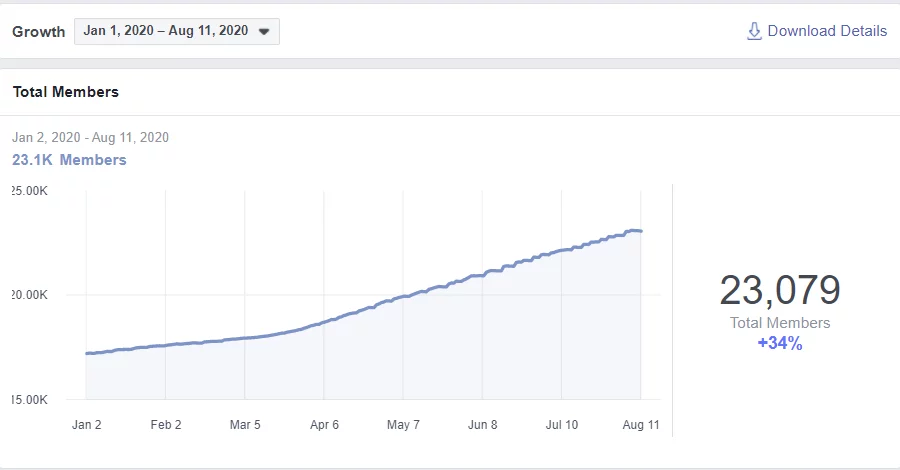
We weren’t surprised to see our group pick up pace starting in March when COVID-19 hit. But if your growth can’t be explained by economic or global trends, look for where that spike came from. Your group may have been shared by members or featured somewhere online.
Get to the bottom of the growth and try to reverse-engineer it. If the growth is coming from something you can control, then you’re on the right track to keep feeding that growth.
Download the free community builder’s kit!
Learning how to create community and following through with it is hard work, but it’s not impossible. There are many free options, like Facebook, available to start your community. But if you want complete ownership and control, or the ability to add a paywall to your community, Thinkific is here to help!
If you’re passionate about what you know, or you want to create a social ecosystem for your most engaged followers. There’s no better time than now to start your online community.
This blog was originally published in November 2022, and was updated in March 2023 to be even more useful.


